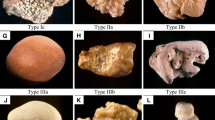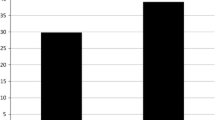Abstract
Calcium phosphate (CaP) stones account for about 15% of all urinary stones, with a marked female preponderance, and reflect a wide diversity of etiology. Variation of the relative prevalence of CaP urolithiasis over time is disputed, and relevance of CaP stone analysis for etiologic diagnosis is underestimated or even negated. Based on the analysis of more than 50,000 stones over the past three decades, we evaluated the changes in the relative proportion of CaP stones between 1980–1989 (period 1) and 2000–2009 (period 2). In addition, using morphologic examination combined with Fourier-transform infrared analysis, we assessed the associations between CaP stone analysis and etiopathogenic factors. Between periods 1 and 2, the overall proportion of struvite-free stones remained essentially unchanged (11.6 vs. 11.1%), with a decreasing proportion of carbapatite stones (10.6 vs. 8.4%, p < 0.001) and a rising proportion of brushite stones (0.8 vs. 2.2%, p < 0.001). Hypercalciuria was associated with 87% of brushite, and 60% of carbapatite stones. Urinary tract infection was associated with presence of minor amounts of struvite and/or with a carbonation rate of carbapatite > 15%. In CaP stones associated with primary hyperparathyroidism, the main component was carbapatite in 66.9% and brushite in 29.1% of cases. Distal renal tubular acidosis was always associated with carbapatite stones exhibiting a peculiar, virtually pathognomonic, morphology. In conclusion, comprehensive analysis of stones involving morphologic examination is of clinical relevance for improved etiologic evaluation of patients with CaP urolithiasis.


Similar content being viewed by others
References
Hodgkinson A (1977) Composition of urinary tract calculi in children of different ages. Br J Urol 49:453
Holmgren K, Danielson BG, Fellstrom B, Ljunghall S, Niklasson F, Wikstrom B (1989) The relation between urinary tract infections and stone composition in renal stone formers. Scand J Urol Nephrol 23:131
Gault MH, Paul MD, Longerich L (1990) Comparison of urinary tract infection in calcium oxalate and calcium phosphate stone formers. Nephron 55:408
Kramer G, Klingler HC, Steiner GE (2000) Role of bacteria in the development of kidney stones. Curr Opin Urol 10:35
Robertson WG, Peacock M, Hodgkinson A (1979) Dietary changes, the incidence of urinary calculi in the UK between 1958, and 1976. J Chronic Dis 32:469
Taylor EN, Curhan GC (2004) Role of nutrition in the formation of calcium-containing kidney stones. Nephron Physiol 98:55
Pak CY, Odvina CV, Pearle MS et al (2005) Effect of dietary modification on urinary stone risk factors. Kidney Int 68:2264
Mandel N, Mandel I, Fryjoff K, Rejniak T, Mandel G (2003) Conversion of calcium oxalate to calcium phosphate with recurrent stone episodes. J Urol 169:2026
Parks JH, Worcester EM, Coe FL, Evan AP, Lingeman JE (2004) Clinical implications of abundant calcium phosphate in routinely analyzed kidney stones. Kidney Int 66:777
Gault MH, Chafe L (2000) Relationship of frequency, age, sex, stone weight, composition in 15,624 stones: comparison of results for 1980 to 1983, 1995 to 1998. J Urol 164:302
Schubert G (2006) Stone analysis. Urol Res 34:146
Gault MH, Chafe LL, Morgan JM et al (1991) Comparison of patients with idiopathic calcium phosphate and calcium oxalate stones. Medicine (Baltimore) 70:345
Maurice-Estepa L, Levillain P, Lacour B, Daudon M (1999) Crystalline phase differentiation in urinary calcium phosphate and magnesium phosphate calculi. Scand J Urol Nephrol 33:299
Daudon M, Doré JC, Jungers P, Lacour B (2004) Changes in stone composition according to age and gender of patients: a multivariate epidemiological approach. Urol Res 32:241
Pak CY, Poindexter JR, Peterson RD, Heller HJ (2004) Biochemical and physicochemical presentations of patients with brushite stones. J Urol 171:1046
Gault MH, Parfrey PS, Robertson WG (1988) Idiopathic calcium phosphate nephrolithiasis. Nephron 48:265
Pak CY, Adams-Huet B (2004) Elucidation of factors determining formation of calcium phosphate stones. J Urol 172:2267
Parks JH, Coward M, Coe FL (1997) Correspondence between stone composition and urine supersaturation in nephrolithiasis. Kidney Int 51:894
Parks JH, Coe FL, Evan AP, Worcester EM (2009) Urine pH in renal calcium stone formers who do and do not increase stone phosphate content with time. Nephrol Dial Transpl 24:130
Devuyst O, Pirson Y (2007) Genetics of hypercalciuric stone forming diseases. Kidney Int 72:1065
Stechman MJ, Loh NY, Thakker RV (2009) Genetic causes of hypercalciuric nephrolithiasis. Pediatr Nephrol 24:2321
Backman U, Danielson BG, Johansson G, Ljunghall S, Wikstrom B (1980) Incidence and clinical importance of renal tubular defects in recurrent renal stone formers. Nephron 25:96
Pak CYC, Poindexter JR, Adams-Huet B, Pearle MS (2003) Predictive value of stone composition in the detection of metabolic abnormalities. Am J Med 115:26
Gault MH, Longerich LL, Crane G et al (1995) Bacteriology of urinary tract stones. J Urol 153:1164
Parks JH, Coward M, Coe FL (1997) Correspondence between stone composition and urine supersaturation in nephrolithiasis. Kidney Int 51:894
Daudon M (1990) Urolithiasis and urinary tract infection. Eurobiol 24:257
Kiffer CR, Mendes C, Oplustil CP, Sampaio JL (2007) Antibiotic resistance and trend of urinary pathogens in general outpatients from a major urban city. Int Braz J Urol 33:42
Daudon M, Bader CA, Jungers P (1993) Urinary calculi: review of classification methods and correlations with etiology. Scanning Microsc 7:1081
Walton RJ, Bijvoet OL (1975) Nomogram for derivation of renal threshold phosphate concentration. Lancet 2:309
Prié D, Ravery V, Boccon-Gibod L, Friedlander G (2001) Frequency of renal phosphate leak among patients with calcium nephrolithiasis. Kidney Int 60:272
Ginalski JM, Schnyder P, Portmann L, Jaeger P (1991) Medullary sponge kidney on axial computed tomography: comparison with excretory urography. Eur J Radiol 12:104
Forster JA, Taylor J, Browning AJ, Biyani CS (2007) A review of the natural progression of medullary sponge kidney and a novel grading system based on intravenous urography findings. Urol Int 78:264
Evan AP, Coe FL, Lingeman JE et al (2007) Mechanism of formation of human calcium oxalate renal stones on Randall’s plaque. Anat Rec (Hoboken) 290:1315
Daudon M, Traxer O, Jungers P, Bazin D (2007) Stone morphology suggestive of Randall’s plaque. In: Evan AP, Lingeman JE, Williams JC Jr (eds) Renal stone disease, vol 900. American Institute of Physics Conference Proceedings, Melville, New York, pp 26–34
Méria P, Hadjadj H, Jungers P, Daudon M, Members of the Urolithiasis Committee of the French Urological Association (2010) Stone formation and pregnancy: pathophysiological insights gained from morphoconstitutional stone analysis. J Urol 183:1412
Griffith DP, Osborne CA (1987) Infection (urease) stones. Miner Electrolyte Metab 13:278
Mandel NS, Mandel GS (1989) Urinary tract stone disease in the United States veteran population. II. Geographical analysis of variations in composition. J Urol 142:1516
Pak CYC (1969) Physicochemical basis for formation of renal stones of calcium phosphate origin: calculation of the degree of saturation of urine with respect to brushite. J Clin Invest 48:1914
Grases F, Costa-Bauza A, Ramis M, Montesinos V, Conte A (2002) Simple classification of renal calculi closely related to their micromorphology and etiology. Clin Chim Acta 322:29
Bergsland KJ, Coe FL, Gillen DL, Worcester EM (2009) A test of the hypothesis that the collecting duct calcium-sensing receptor limits rise of urine calcium molarity in hypercalciuric calcium kidney stone formers. Am J Physiol Renal Physiol 297:F1017
Prié D, Huart V, Bakouh N et al (2002) Nephrolithiasis and osteoporosis associated with hypophosphatemia caused by mutations in the type 2a sodium-phosphate cotransporter. N Engl J Med 347:983
Levi M, Breusegem S (2008) Renal phosphate-transporter regulatory proteins and nephrolithiasis. N Engl J Med 359:1171
Tang R, Nancollas GH, Giocondi JL, Hoyer JR, Orme CA (2006) Dual roles of brushite crystals in calcium oxalate crystallization provide physicochemical mechanisms underlying renal stone formation. Kidney Int 70:71
Klee LW, Brito CG, Lingeman JE (1991) The clinical implications of brushite calculi. J Urol 145:715
Evan AP, Lingeman JE, Coe FL et al (2005) Crystal-associated nephropathy in patients with brushite nephrolithiasis. Kidney Int 67:576
Carpentier X, Daudon M, Traxer O et al (2009) Relationships between carbonation rate of carbapatite and morphologic characteristics of calcium phosphate stones and etiology. Urology 73:968
Bouzidi H, David de Brauwere D, Daudon M (2010) Does urinary stone composition and morphology help for prediction of primary hyperparathyroidism? Nephrol Dial Transpl. doi:10.1093/ndt/gfq433
Author information
Authors and Affiliations
Corresponding author
Additional information
Proceedings paper from the 3rd International Urolithiasis Research Symposium, Indianapolis, Indiana, USA, 3–4 December 2009.
Rights and permissions
About this article
Cite this article
Daudon, M., Bouzidi, H. & Bazin, D. Composition and morphology of phosphate stones and their relation with etiology. Urol Res 38, 459–467 (2010). https://doi.org/10.1007/s00240-010-0320-3
Received:
Accepted:
Published:
Issue Date:
DOI: https://doi.org/10.1007/s00240-010-0320-3




